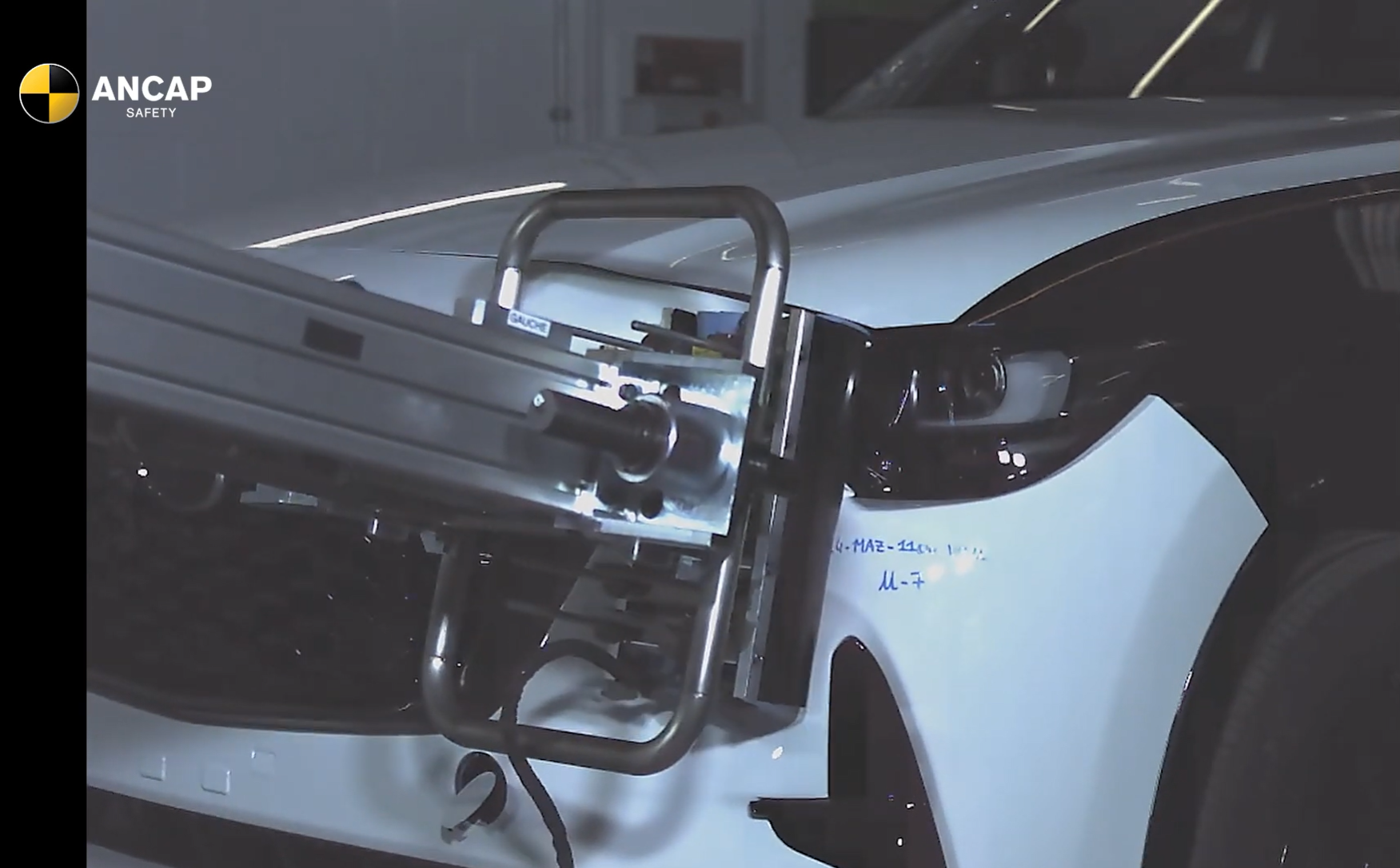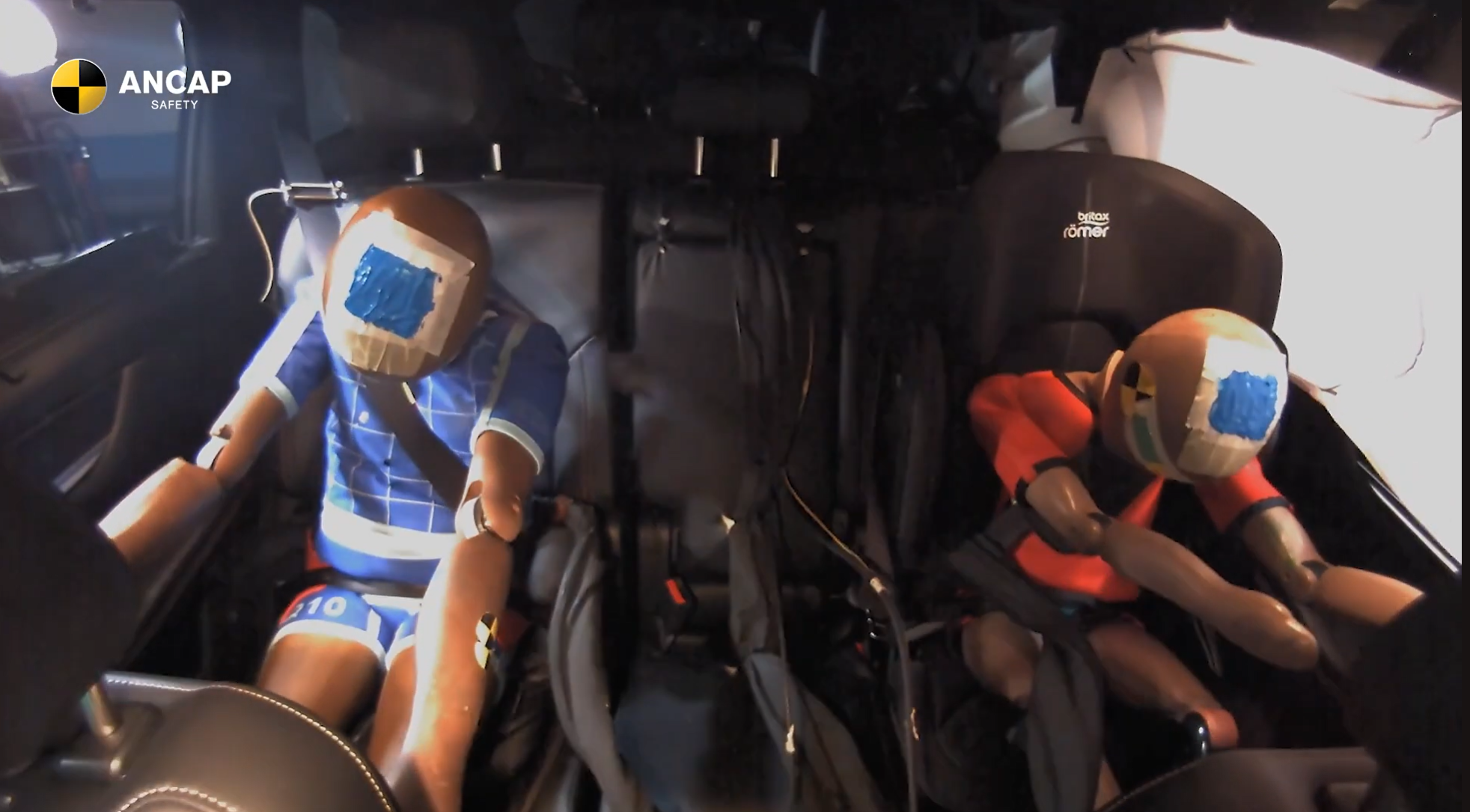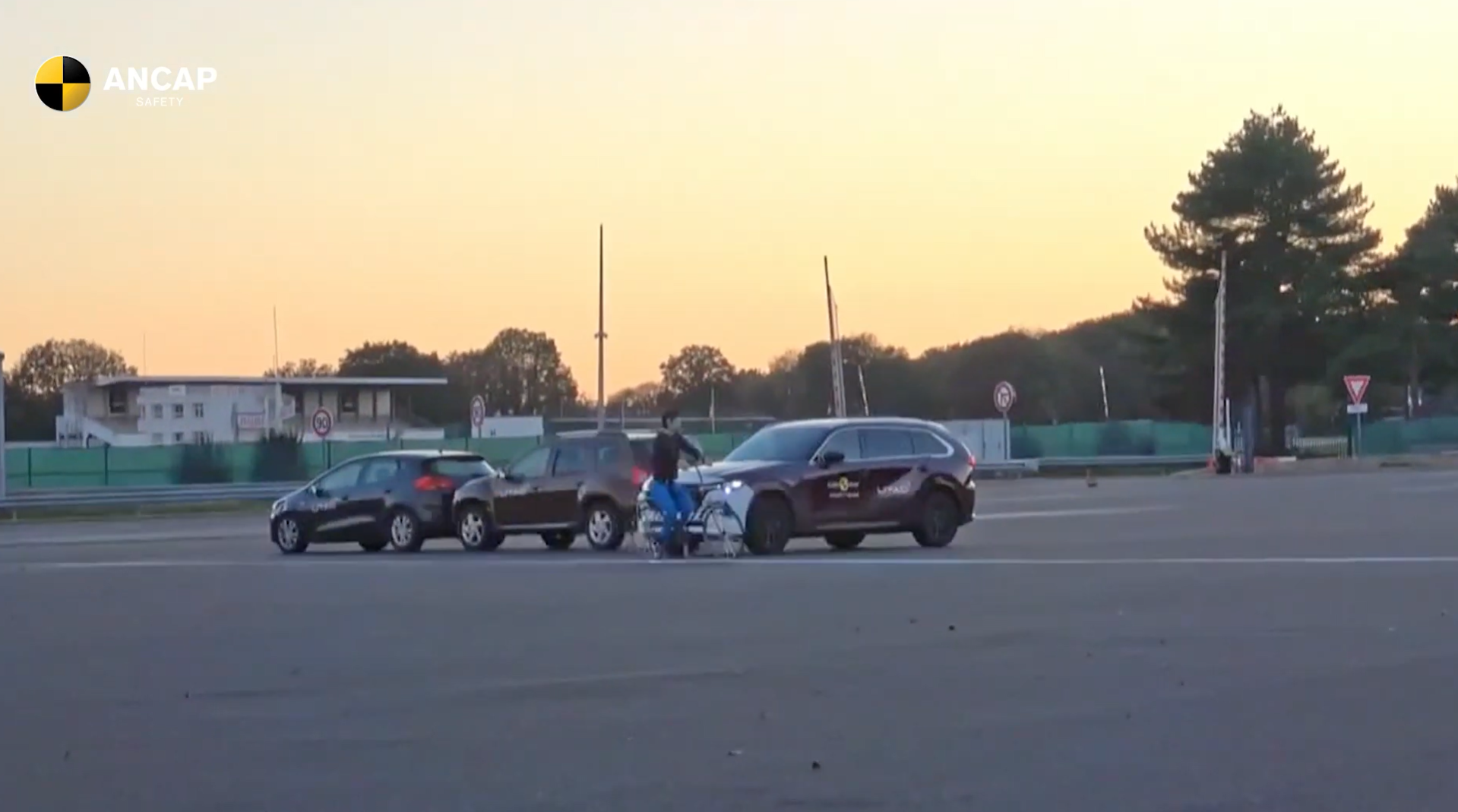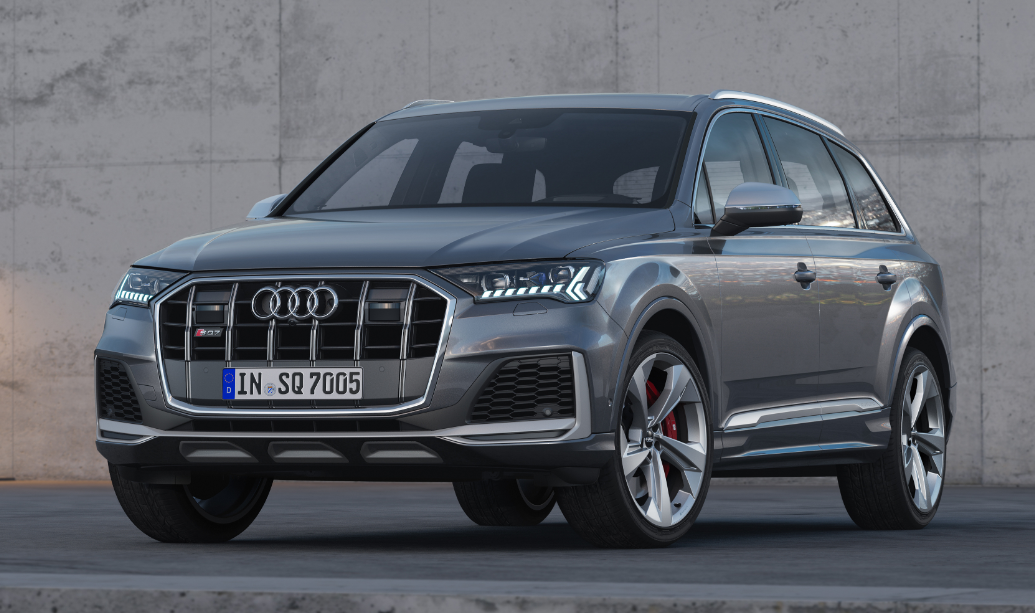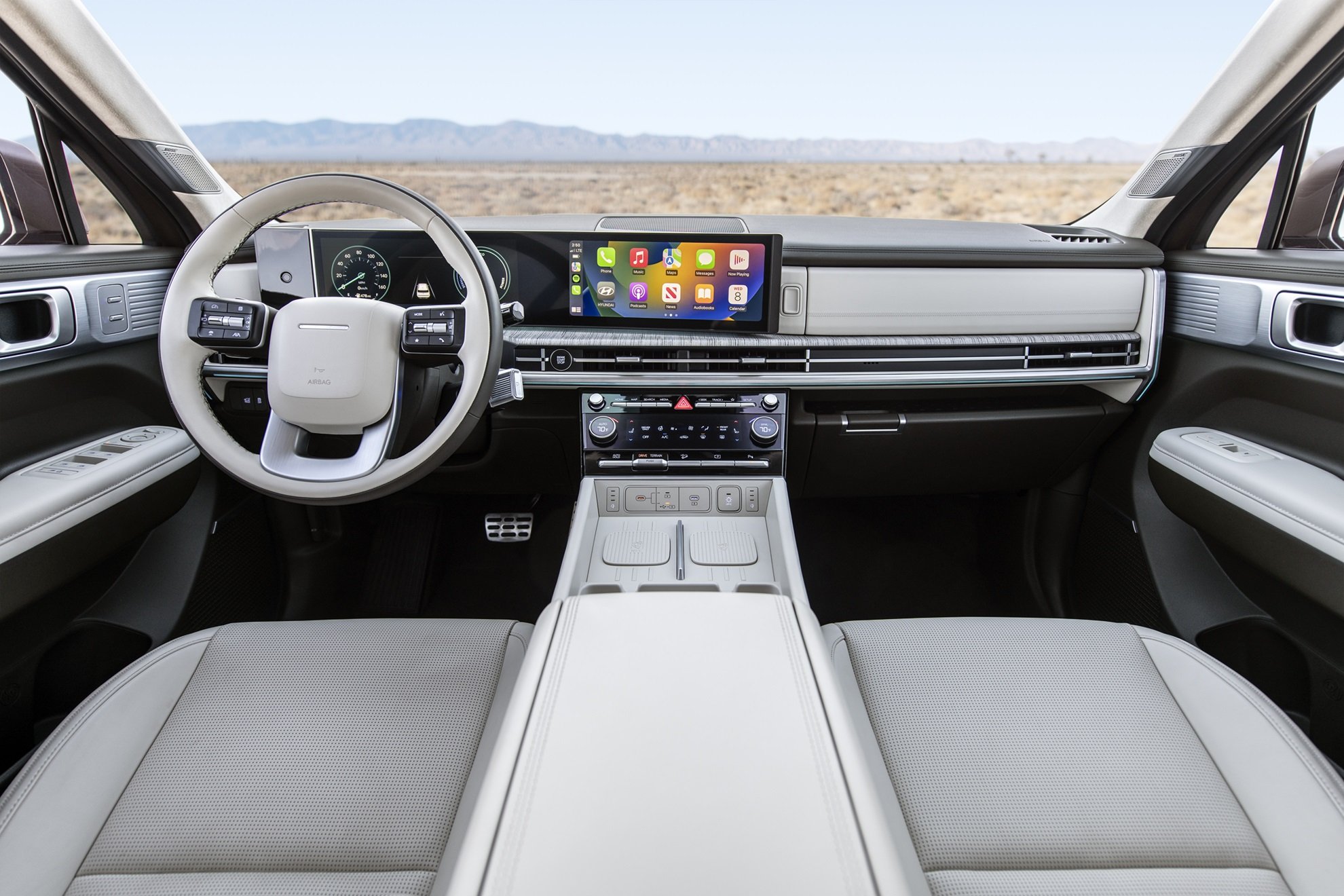Mazda CX-80 review and buyer’s guide
The Mazda CX-80 is yet another seven-seat family SUV that flies in the face of premium-priced German luxury. It offers prestige and power, with a big helping of practicality. But can it represent good value against its rivals?
The Mazda CX-80 is a seven-seat version of the CX-60 that offers a luxurious medium-large SUV package with the addition of two extra seats to buckle in.
It offers similar pricing, the same body, the same size and proportions, and even the same powertrain. So apart from the additional seats, what else can it possibly do to differentiate from the CX-90 (itself a 7-seat version of the CX-70) or indeed other SUVs in this category?
What makes it worth your consideration if you’re shopping for a medium-to-large SUV with seven seats, lots of leather and a grunty engine? The answer might surprise you…
There’s no hiding the fact that Mazda has taken an interesting product planning decision to lob four (count them, four) big luxury SUVs that aren’t cheap and certainly look imposing. It seems peculiar that such a big brand would make what seems like a foolhardy choice to potentially cannibalise its own sales, and offer too many choices.
It’s a bit confusing when you realise the CX-60 and CX-80 are the same overall vehicle, effectively, and then the CX-70 and CX-90 are virtually identical as well. And to be fair to you, the consumer, all four vehicles look exactly the same.
Having said that, it is a fairly good-looking vehicle - your subjective aesthetic taste may vary. But more to the point, it offers you an opportunity to save tens of thousands that you might’ve spent on its rivals like the Audi Q7, Mercedes GLE, BMW X5 or Volkswagen Toureg.
Alternatively, the CX-80 (like the CX-60, 70 and 90) offer another alternative to the Hyundai Santa Fe which has gone hybrid, or the Kia Sorento which retains its 2.2 turbo-diesel, the Mitsubishi Outlander, the Toyota Kluger, or even the Subaru Outback to a certain extent in the context of the five-seat CX-60 and 70 respectively.
There’s also a good point to be made that if you’re looking for a big family SUV with a performance streak (but you perhaps can’t quite stomach the huge price premium for, say, an X5 M or SQ7, or even something properly outrageous like a Porsche Cayenne), the CX-80 is a good compromise.
You get that torque-driven shove from the 3.3-litre turbo-diesel straight six, or the growl from the same configuration engine running petrol instead for a high-revving, punchy rear-wheel drive experience. Or there’s a plug-in hybrid if you like the idea of running silently on your morning commute.
FEATURES & PRICING
There are four model grades in the CX-80 range, with the choice of either a:
mild-hybrid turbocharged petrol 3.3L straight six;
mild-hybrid turbo-diesel 3.3L straight six;
or the 2.5-litre turbo-petrol straight-six plug-in hybrid (from ‘Touring’ variant up)
To make your life simpler when it comes to deciding what you want from this high-riding luxury 7-seater, the plug-in hybrid (PHEV) is roughly $11,000 more than the diesel, and about $13,500 more than the standard turbo-petrol.
It’s 13 per cent more expensive than the diesel just to gain 65km of claimed EV-only driving range and a combined-cycle fuel economy claim of 2.7L per 100km. That $11K could’ve bought you 99 tanks of diesel.
There’s the ‘base’ model ‘Pure’, which is anything but base. Second from base is the ‘Touring’ before the penultimate ‘GT’. Then there’s the Azami with a bunch of finishing touches that make it feel just as luxurious as an Lexus or BMW X5.
The Pure is available as a petrol-only fleet manager’s pick, while the Touring starts with the three powertrain choice.
All CX-80 variants get a ‘Sport’ mode, a ‘Towing’ mode and an ‘Off-road’ mode but keep in mind these are just predetermined computer programs for remapping the throttle, traction control, the stability control and the steering weight.
As for the configuration of CX-80, in the top-spec Azami you can have the row-2 captain’s chairs when you select the ‘SP’ package that also makes the seats tan leather, the wheels 20 inches of black metallic alloys, and a centre console is fitted for the storage demands of your darling children. (There’s also a bunch of gloss black trims, and ‘dark signature’ design LED headlights as opposed to the normal LED headlights with the brighter design.)
Choosing a regular Azami, GT, Touring or Pure, you’re getting a seven seats.
CX-80 ‘PURE’ | G50E (petrol) $60,200 (d/a)
You get:
10.25-inch full colour widescreen display (Mazda Connect) and 7-inch driver’s display
18-inch Black metallic alloy wheels
Adaptive LED Headlamps (ALH), auto high-beam control, LED taillights
8-speaker stereo
360-degree camera, front and rear parking sensors, side-door exit warning
Apple CarPlay and Android Auto (wireless and USB)
Electric tailgate, auto folding heated door mirrors, auto rain-sensing wipers
Black cloth seats with electric adjustment (driver & passenger)
Heated seats (front), tri-zone climate control
1 x 150w AC power outlet
Adaptive cruise control, auto emergency braking (incl. reverse), blindspot monitoring, lane keeping,
CX-80 ‘TOURING’ | G50E (petrol) $67,500 (d/a) | D50E $69,500 (d/a)
You add:
12.3-inch full colour widescreen display (Mazda Connect) and 12.3-inch TFT LCD multi-information meter display
Adaptive LED Headlamps (ALH)
Wireless phone charging
Personalise system (auto restoration of settings)
Active driving display
Apple CarPlay and Android Auto (wireless and USB)
Hands-free remote operated power tailgate (open/close)
Leather seats with power adjustment (driver 10-way & passenger 8-way) and position memory (driver)
Heated seats (front)
CX-80 ‘GT’ | G50E (petrol) $74,700 (d/a) | D50E $76,800 (d/a)
You get:
12.3-inch full colour widescreen display (Mazda Connect) and 12.3-inch TFT LCD multi-information meter display
21-inch Black metallic alloy wheels
Adaptive LED headlights (ALH)
Panoramic sunroof
Personalise system (auto restoration of settings)
Premium 12-speakers Bose stereo with amplifier
360-degree camera
Active driving display
Apple CarPlay and Android Auto (wireless and USB)
Hands-free remote operated power tailgate (open/close)
Leather seats with power adjustment (driver & passenger) and position memory (driver)
Heated seats (front and rear outboard)
Heated, electrically adjustable steering wheel W/ position memory
CX-80 ‘Azami’ | G50E (petrol) $80,100 (d/a) | D50E $82,200 (d/a)
For that extra $7000-8000, you include:
360-degree camera w/ frontal see-through function
Ambient lighting
Black Nappa leather or optional Burgundy nappa leather seat trim with quilting (at no extra cost)
Body-coloured wheel arches and lower cladding
Cruising and traffic support
Frameless interior mirror
Interior foot lamp (front and rear)
Personalisation system for automatic driver positioning
Ventilated seats (front), front passenger seat lumbar adjustment
Body-colour exterior side door handles
When you choose the Azami, an optional SP Package is available for a further $3500, which offers:
Tan Nappa leather seat trim
Suede finish dashboard panel
Two-tone colour steering wheel
All up, you can potentially outlay nearly $90,000 for a CX-80 Azami, once you include on-road costs.
INTERIOR
Arguably, Mazda makes the best interiors among the mainstream car brands.
At each model level, be it small hatchback or medium sedan, from small SUV to medium SUV, and even up here at the dizzying heights of a luxury seven-seater - Mazda knocks it out of the park.
Luggage space in a CX-80 is a bit hard to compare with other models because Mazda’s gone to the effort of making it an uneven playing field by including the underfloor storage area, while also measuring up to the top of the rear seats and not the roof.
Mazda uses the VDA method for measuring cargo space, which is good (because it’s the most accurate), but nobody else measures their boot’s cargo volume using the underfloor. so keep that in mind when you read the minimum quoted volume behind the third row of seats is 258 litres. Behind the second row of seats (with row 3 down), there’s 566 litres, and if you drop the second row as well, there’s a claimed 1971 litres back there.
If you ever planned to use the full extent of the CX-80’s boot with row 2 collapsed, say for a piece of abnormally long furniture or perhaps a big TV etc., you might want to go putting something protective over the fully tan leather seatback to avoid tears, indentations or scratches.
It’s important to understand and distinguish a low-level Audi Q7 or BMW X5 from the entire Mazda CX-80 range. It’s not just the top-tier Azami that is well equipped and gets the grunty engines - it’s the lower tiers as well.
See, in a Q7 or X5, the base and middle-spec variants are very limited in what they offer you, preferring to sell you additional equipment in expensive packages. It’s how they make so much more profit.
But the CX-80 doesn’t do that. The Touring or GT already give you some of the good features you want. Things like adaptive LED headlights or wireless charging, or the powered tailgate or heated seats.
An Audi Q7 45 (the base model) is $108,000 before on-road costs, but doesn’t come standard with a panoramic sunroof like in the CX-80 GT. Audi wants another $4000 to add it.
The X5 30d X-Line (the base model) already costs $134,500 before on-road costs, but BMW expects you to pay $8500 for the ‘Executive package’ which includes gesture control, ventilated (cooled) front and rear seats, and massaging headrests in order to get the sunroof.
Granted, the CX-80 Azami, even with the SP package, doesn’t get massaging headrests, but how often are you really going to need a head massage while driving? Saving thousands of dollars you could have endless full-body massages at your local, if you bought the CX-80 instead, which offers ventilated front seats in the Azami, adding it to the rear captain’s chairs with the SP pack.
Quad-zone climate control that pumps cool air all the way up the back - that’s a $3900 package in the Q7 and just $100 less in the X5’s ‘Comfort’ package. Tri-zone climate control is standard on the notionally poverty pack ‘Pure’ CX-80, at about $60,000 driveaway. And the Mazda’s AC system does include rear controls for the kids.
And it’s not like you’re going to get any better legroom in the German SUVs. Wheelbase (which translates into interior legroom) is 3 per cent better in the CX-80 than the Q7 (which is already longer than the X5).
I'll help you save thousands on a Mazda CX-80
Just fill in this form.
No more car dealership rip-offs.
Greater transparency.
Less stress.
ENGINE
The powertrain choice for the new Mazda SUV range is so godit might make you feel a little guilty, even car enthusiasts.
Mazda has chosen to fly in the face of the EV/hybrid craze, offering you the choice of a 3.3-litre inline six-cylinder engine in petrol or diesel form, both turbocharged for increased volumetric efficiency. You can also have a plug-in hybrid as mentioned earlier, but let’s stick with the more common engines for the moment.
First off, the fact you actually get a choice of engine is remarkable in an era where carmakers have, generally speaking, slashed their powertrain offersing (or at least heavily shrunk it), where you’ll often see the same engine in multiple models and only the equipment and driveline differs. You might get front-drive or all-wheel drive, but the same engine, even if you buy the top-of-the-range.
But, no. Mazda has gone in a different direction. They still have to abide by corporate average fleet emissions, which is why the CX-80 is a mild hybrid like the CX-60, -70 and -90, but all four models get the same range of what is a pretty big engine in a sea of tiny ones.
And none of the other mainstream brands does a straight six anymore. Here’s why inline sixes are so perfect >> in a technical sense. But here are the headline facts you need to know about these powertrains.
The petrol engine is about performance, as in, you like driving, you like the sound of a petrol engine, you like revving, changing gears and you’re not really fussed about being a stickler for fuel economy.
The petrol engine is called e-Skyactiv “G” (for gasoline) and is turbocharged, making 209kW of peak power and 450 Newton-metres of torque between 2000 and 33500 revs. That’s right in the goldilocks zone for where you want all the torque (courtesy of the turbocharger). But if you want peak power, because you need to accelerate harder to overtake a truck, say, you’ll be finding the grunt at 500-6000 revs.
Fortunately, the petrol runs on 91 RON fuel because it consumes about 8.4 litres per 100km - which is 60 per cent more than the diesel.
The inline-6 e-Skyactiv “D” turbo diesel engine shortens your journeys with a punchy 187 kW of peak power but at only 3750 revs and, thanks to the inherently greater energy density of the fuel, offers a surge of 550 Newton-metres of torque. That torque might be greater, but it’s the peak power at just 1500 RPM up to 2500 RPM that makes the CX-80 gallop.
All this power is a pretty big deal by today’s standards, particularly given the emissions regulations in play currently, forcing carmakers to go hybrid, or force-feed fully electric cars to consumers.
German brands peak at around 3.0 litres with their engine capacities, although typical of Mazda to offer higher-capacity units such as the current 2.5-litre turbo four-cylinder in CX-5. Only Subaru still runs an engine that big among the mainstream brands.
So which engine would you pick, notionally? Well, that depends on you…
The facts and figures on these new engines are impressive, but so is the inherent design of the straight-six.
An inline-six has a firing order that is mirrored on the opposite side of the cylinder bank, so the reciprocating forces are balanced out - meaning no balancing shafts or counter weights are needed to prevent the engine tearing itself apart. No counter weights means less reciprocating mass, less vibration, and of course - less weight. This increases longevity, allows you to increase the power without any inherent side effects, and it’s just smooth to drive.
Inline sixes are also less complicated thanks to having one cylinder head and just two camshafts - fewer parts, less to fail.
The (diesel) D50e offers that beefy 550Nm of torque, which is what you want for big holiday trips with lots of kids, heavy luggage bags, Eski and effectively half your house (or so it feels like) shoved in the back for a long weekend or school holidays away. You might also add roof racks and a luggage pod, possibly a bike rack on the back or a light trailer.
All of this kind of family use is screaming, ‘Get the diesel.’ Not only is diesel the more efficient fuel (because it has greater energy density: more energy derived per unit of fuel), but that torque is what you’re going to use to get the big, heavy mass going from the lights, but also on long, steep hills, overtaking trucks and any kind of towing or payload assignment.
Performance is very respectable, especially with all of that torque, but fuel economy is outstanding in the context of its kerb weight and the level of luxury.
The regular petrol version attracts Luxury Car Tax while the diesel and plug-in hybrid do not, thanks to the latter two having good combined fuel economy figures. Think of the G50e as like an X5 without the M-sport package, and without the $154,000-ish pricetag attached, that includes about $14,000 in LCT. The Mazda attracts just $1000 in LCT.
Mazda says the diesel offers the lowest official consumption average of any other vehicle in its class (excluding hybrids), with a rating of just 5.2L/100km. That’s incredible for this size engine and for its outputs - and we have the nature of it being a more energy-dense hydrocarbon fuel to thank for that. (It’s why diesel fuel isn’t going away in Australia >>)
The performance version of CX-80 is the plug-in hybrid, the P50e, which makes 241kW of peak power that uses 129kW from the AC electric motor that gets the 2.26 tonne mass going before the 2.5-litre 4-cylinder petrol engine kicks in to deliver its maximum 141kW at 6000 RPM.
That’s seriously impressive - for something as civilised and family-conscious as the CX-80. It might only make half of the BMW X5 M plug-in hybrid’s power (an astonishing 360kW, just to be clear), but the Mazda is roughly 72 per cent cheaper. That’s value.
Fuel consumption is quoted at a very low 2.7L per 100km, but the PHEV does take 95 RON, so keep that in mind.
It’s the same story on fuel consumption with the diesel CX-80. Considering the engine size and power is almost the same as the Beemer 30d with its official combined consumption claim of 7.8L/100km while making 210kW, but costs $70,000 more, to make 23 kilowatts more than the CX-80 diesel which consumes roughly 50 per cent less fuel.
The CX-80 destroys any rational argument for buying a premium German diesel SUV.
Mazda's 3.3 inline-6 turbo-diesel is, in terms of power-to-weight ratio, down on the BMW X5 diesel. It’s 97 kW per tonne to the Beemer, and 92kW for the Mazda. Just 7kW in it, and what does that mean to you? Next to nothing in the real world, sitting in traffic, heading out on the highway for school holidays or towing a light trailer with some furniture.
Hyundai’s Santa Fe hybrid offers similar dimensional size, luggage and refinement as the CX-80, and similar fuel economy as Mazda’s inline-six diesel. But the Santa Fe has the advantage of offering instantaneous torque from zero revs courtesy of its small battery capturing kinetic energy from the brakes.
The CX-80 does this too in its mild hybrid petrol and diesel engines, and certainly the plug-in hybrid goes one-up with the ability to run in EV mode for a claimed 65km range (more like 40 in real life (not on paper)), leaving you to be recharging quite often.
For CX-80, its official combined cycle fuel economy claim is 5.4L to the Azami diesel, and it’s 5.6L to the Santa Fe Calligraphy with its 1.6 turbo-petrol hybrid that makes a combined power output of 174kW. That’s negligible.
In power-to-weight ratio, the Santa Fe has 83kW per tonne compared with 92 in the CX-80, with those very handy row-three seats. And it’s $12,000 cheaper than the Mazda.
The CX-70 and -80 feel surprisingly sporty and willing to drive than their size and weight might first impress upon you. CX-80 feels like a German SUV and compared with the hybrid Santa Fe, it also feels more special - although that’s a verynambiguous and subjective term to use.
So the CX-80 absolutely outpaces the Santa Fe Calligraphy, and can tow 50 per cent more weight (notionally), but the Santa Fe offers more luggage volume in the boot, and is 5 per cent lighter.
Overall, the CX-80 sits in a niche above the ordinary large SUVs from Hyundai, Kia, Toyota and Mitsubishi, outpacing them in raw performance and tangible luxury, but the beefy Mazda also embeds itself uncomfortably close to the elite brands like Merc, Audi and BMW. It makes them look overpriced and like they’re trying a big too hard.
An certainly your Mazda CX-80, it must be said, is going to be more reliable than an Audi Q7, Mercedes GLE, and the X5, so there’s that.
TRANSMISSION
Mazda’s decision to stick with epicyclic automatic transmissions with torque converters is what has made them quite good in both highway driving and city commuter traffic.
The CX-70 gets an 8-speed auto that, like the CX-60 and 90, is so quick on upshifts it feels like a single reduction-type gearbox like you get in EVs, and then on the way down, it’s smooth and doesn’t lurch you forward under longitudinal negative-G. The brakes do, but that’s only because they’re doing what they’re supposed to do: bring this 2.2-tonne vehicle to a stop.
Hitting the brakes will tip kinetic energy back into the 48-volt battery system to reuse it during idle and heavy load such as taking off from stationary.
Stop-start city driving with Mazda’s transmissions is generally a very smooth experience. Statistically, they never mis-shift ever, they’re always in the right gear, and know instinctively when to kick-down upon request with your right foot to accelerate, such as to overtake on the freeway.
It’s a very hard gearbox to trick or confuse, and nor does it hunt around for the right gear.
In terms of offering that refinement of a nicely tuned transmission that responds to your inputs, Mazda is hard to beat, even on an inline-six turbo-diesel.
It’s also worth appreciating that Mazda hasn’t felt the need to reinvent the transmission shifter, so to speak, by putting a stalk on the steering column where you can’t find it, get confused about which way to twist for ‘drive’ or ‘reverse’ and then bash it with your knee because of your long legs.
They’ve left it on the central transmission tunnel, but they’ve made it smaller, given it shape and a refined, super-slick shift. And the action itself feels solid, yet easy. It doesn’t feel mechanical, despite the fact you are very much using your hand to notch it into ‘D’ or ‘R’.
You can also revert to the paddle-shifters behind the steering wheel, however, their general location for your fingers might be comfy or cramped depending on how big your hands are and how long your fingers are.
Downshifts are a nice balance between engaging for the driver and smooth enough that there are no weird feedback effects. Feeling the ‘old school’ nature of the rear-biased AWD means you feel stable and flat on twisty, downhill braking sections while changing down the gears.
As opposed to front-biased systems of old where the front tyres feel like they’re dealing with too much input at once: steering, gear changes and braking - which can lead to understeer.
TOWING
Towing and payload are inexorably tied together because the GVM is connected to the 506kg payload of the CX-70. The GVM is 2722kg, meaning that if you were to load up with maximum payload (including kids, luggage etc) you’re left with 2216kg - the exact kerb weight.
The maximum braked towing capacity of CX-70 is 2500kg, which, hypothetically, would put a notional 250kg of download on the towball. Except you can’t because the CX-70 is limited to just 150kg on the towball, which means a potential just 6 per cent of the trailer restrained by this 2.2-tonne vehicle.
This means two things. First, that if you add a trailer that puts 150kg on the towball, which is counted as payload, you’re limited to just 356kg of payload. If you, the driver, weighs 100kg, you’re left with 256kg for your family: the wife, the kids, all your stuff - and any accessories you might’ve liked to include. This might include roof racks, luggage pod, whatever.
The second result of these sums is that restraining a 2.5-tonne load with just 150kg borne by the CX-70 is potentially an unstable combination, perhaps in the wrong conditions, or in the event of some kind of emergency braking or swerving manoeuvre.
Towing is still possible, obviously, you just need to make absolutely certain that it’s a conservative combination. Avoid going over the 2000kg watermark to make sure you remain well inside the safe working limit.
FUNCTIONALITY
The doors on a Mazda CX-80 open at a damn-near perfect 90-degree angle. That’s a huge victory for mums and dads who have to deal with child restraints, especially adults on the taller side who can find themselves trying to slip their large frames between the C-pillar and the rear door frame while trying to get their kids in and out.
Having doors open as such a useful angle also makes cleaning the car significantly easier. Getting into the footwell, removing floor mats and trying to fetch any fallen toys or shoes or food from under the front seats - all made easier by doors that actually open and get out of the way.
Unfortunately the CX-80, which is a 7-seater (it’s effectively a CX-60 plus row three), has an enormous boot space - but they’ve only managed to get a space-saver spare wheel under the floor.
This is a packaging thing Mazda has done for years, sticking only space-saver temporary spares into even its biggest SUVs, and with all-wheel drive. It’s not entirely bad news, because it does mean more space for designing the actual vehicle, and punctures are statistically fairly rare - and if you’re a Mazda customer, chances are you’re using it in places where a tyre shop isn’t far away.
It’s also unlikely you’re looking to take your CX-70 into the outback, but certainly regional touring can be tricky getting around on a temporary spare limited to 80km/h. A space-saver does, of course, help Mazda (rein in the weight a little bit) and save space .
The CX-80 gets 598 cubic litres of volume behind the back seats. That’s just 52 litres shy of the $150,000 BMW X5 base model, or a difference of just 8 per cent. However it is also less than the 628 litres on offer in the Hyundai Santa Fe, which also gets additional functionality of row-three seats for about $12,000 less than the CX-80. And the CX-80 isn’t exactly going to be significantly better on fuel economy than the hybrid Santa Fe.
Unless you don’t care about fuel economy much, in which case, the Mazda is certainly going to be more engaging to drive as opposed to silent at low speeds in the Hyundai. It depends what you enjoy.
The CX-80 gets three top tether anchor points on the back of row two, two of which are in plastic guides and one partially hidden behind a slit in the backing fabric. Two pairs of outboard ISOFix points are also in guides in row 2.
A 220-volt 3-pin plug outlet capable of 150 Watts of draw can be found in the boot (that’s good enough to run most portable fridge/freezers and automotive air compressors), as well as the typical 12-volt round power outlet.
There’s also a hidden storage compartment under the rearmost section of the back row of seats, which you can only access by tilting the whole seatback forward in order to release the lid from being captured by the seat’s reclined state. Additional underfloor storage can also be found when you lift the luggage compartment floor.
That floor, by the way, must be over a metre long to the bottom of the seatbacks.
SAFETY
Mazda CX-80 gets a very impressive crash test score for occupant protection, with 92 per cent in adult occupant protection, and 87 per cent in child occupant protection.
In each of these categories, it scored 37 out of 40, and 43 put of 49, respectively, as tested by EuroNCAP in late 2024. The results apply to all petrol, diesel and plug-in hybrid variants.
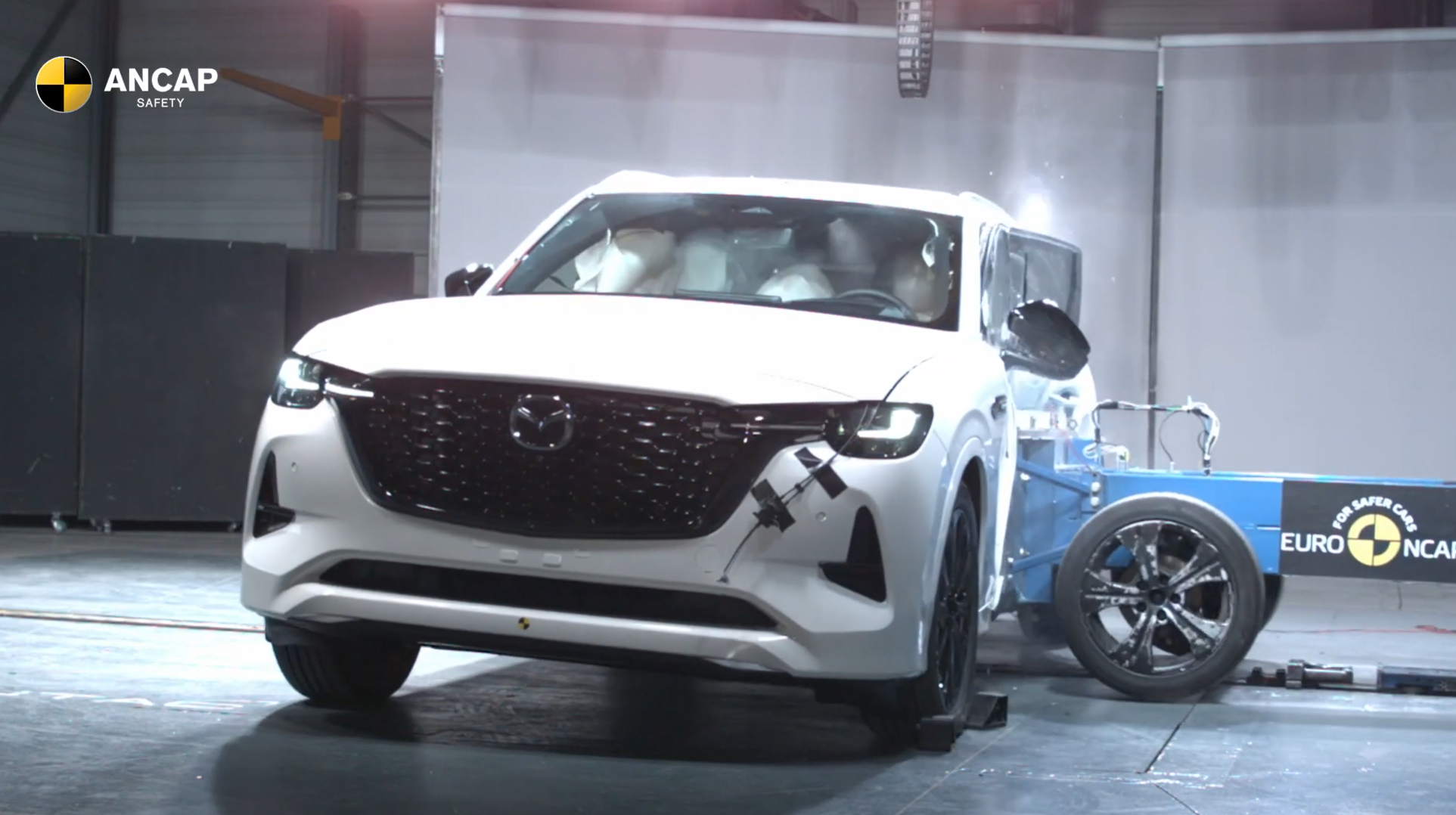
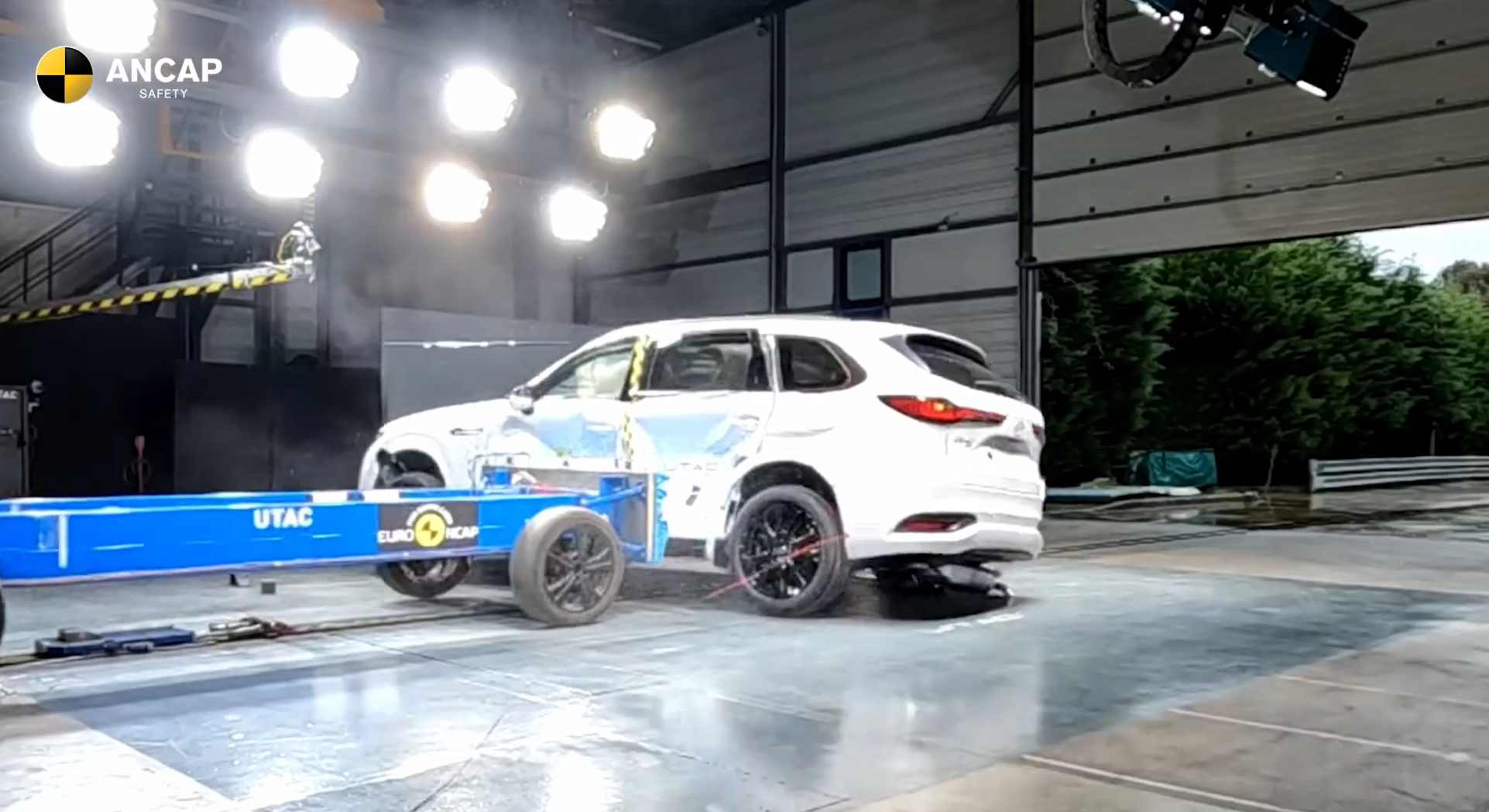


What’s good to see here is the third seating row’s curtain airbag deploys to cover the C and D pillars. You can see it most clearly in the full width test (above).
A driver’s knee airbag and centre airbag are present, of course, and despite the tall, slab-like and rather boxy front end grille area, for vulnerable road user protection it also scored quite well in terms of pedestrian tests.
Overall, CX-80 got 84 per cent in vulnerable road user protection (VRU), with 53 out of 63 possible points. In the pelvis test, which simulates hitting a pedestrian in the pelvic region (the body’s central pivot point) it scored a perfect 4.5, as well as in the femur test, presumably on a fairly tall person considering the CX-80’s size.
The CX-80 does put a few feet wrong in the so-called driver assist category, which has thus far been the most contentious area for rating modern vehicles, not just because it tends to trip up these fairly complex systems, but also because the scoring has been a rich source of conjecture to anybody with a technical background.
The main deduction the CX-80 received was in the AEB (auto emergency braking) ‘Junction’ feature, which failed to recognise the oncoming motorcycle dummy the Mazda was crossing paths with.
For some balanced perspective here, the test is done 9 times, using a motorcycle travelling at speeds of 30km/h, 45km/h and 60km/h. At each target motorcycle test speed, the Mazda also does three different speeds: 10km/h, 30km/h and 60km/h. It scored, overall, ‘Poor’ for all three.
To be fully aware of the difficulty of this test, the forward-facing radar extends from the vehicle in a cone shape, getting wider the further away from the vehicle. But what happens in this test is the CX-80 is in fact stopped before the motorcycle actually crashes into it.
This suggests that the motorcycle is probably outside of the radar’s arc range on its approach. Then, as it does come within the radar’s threshold, the CX-80 does actually stop. See below: the CX-80 has stopped at this point.
What we do learn here is that these systems do have holes in them and it remains the driver’s responsibility to see the motorcycle coming and stop accordingly; it’s also in the motorcyclist’s best interests to reduce speed at an intersection to avoid a crash.
The motorcycle is also quite a narrow target with a small cross-section, especially when moving at 8 metres per second. In the equivalent bicycle test, where the CX-80 stopped in time and the bike has an even smaller cross-section, the bike is doing much less than 30km/h.
In summary, this is not a very hard test and the CX-80 should’ve passed, which Mazda most likely knew in advance it probably wouldn’t perform well in and chose to not bother accounting for, or they might simply design a software update for as a result of the test.
Does this make the CX-80 a terrible vehicle - absolutely not. It excels in almost every other measurable way on safety. No car is perfect and now you know one of the CX-80’s small flaws so you can make an informed choice. In fact, CX-80 out-scores the Hyundai Santa Fe in Safety Assist, and yet, it’s ‘driver assist’ features are, arguably less intrusive while the Mazda also doesn’t have a driver monitoring system that distracts and annoys anything like Santa Fe’s. And the Hyundai doesn’t get row 3 curtain airbags either, so there’s that.
And yet both are perfectly safe, efficient and high-quality 7-seat SUVs. Two things can be true at the same time.
DRAWBACKS
The glaring downside to this impressive, luxurious range of big new family Mazdas is - they’re all given space-saver spare wheels.
Now, for many, this may not be a problem in the majority of daily routine driving you’re likely to do within the outer edge of most metropolitan cities where there’s a tyre shop or mechanic around that can help if you get a flat.
But in the case of actually wanting to visit regional tourist destinations, which can be hours between towns, especially on weekends and public holidays when everything is closed after 5pm and doesn’t open before 9, if at all on Sundays - a temporary spare can be a problem.
Besides just the gross inconvenience, it’s also the technical limits it puts on the vehicle. Getting around on a doughnut, with 500kg of family, luggage and push bikes, on potentially sketchy backroads, in the rain, or on dirt roads, or getting out of the sandy beach carpark can be hard work on the spare.
Also, you’re an additional 500kg heavier, and supposed to be running in AWD, in some conditions, meaning the space-saver is doing more work than the standard 21-inch alloy wheel and tyre. Speaking of, space-savers are limited to 80km/h, so getting home can be slow.
MAIN COMPETITORS
Here are the key specifications on each of the Mazda CX-80’s main market rivals which you might compare it to in both the mainstream brands and the prestige brands Mazda wants to disrupt.
BMW X5 xDrive 30D xLine | diesel | $134,900 before on-road costs (approx.)
PERFORMANCE
Engine: 3L turbo in-line 6 || Power: 210 kW @ 4000 RPM || 650 Nm @ 1500-2500 RPM || Power-to-weight ratio: 97 kW/t || 0-100km/h: 6.1 sec || Fuel cap.: 80L || Combined fuel consumption: 7.8L/100km (claimed)
Driveline: Permanent AWD 40:60 (front:rear), 8-speed epicyclic sports-automatic
SIZE & WEIGHT
L: 4935mm W: 2004mm H: 1765mm || Wheelbase: 2975mm
Kerb weight: 2220kg Turning circle: 12.6m Ground clearance: 216mm
Luggage space: 650L (row 2 up), 1870L (row 2 down)
Towing: 2700kg braked (180kg towball d/load) | Max payload: 544kg | GVM: 2950kg
DRAWBACKS:
Runflat spare tyre
Max. towball download only 180kg (just 6% of the maximum towing capacity)
$13,000 Luxury Car Tax
OPTIONAL EXTRAS:
Adaptive self-levelling air suspension | $2500
Premium Bowers & Wilkins ‘Diamond’ surround sound | $8000
Comfort pack: Heated steering wheel, quad-zone climate control, heated/cooled front cupholders, ehated row 2 seats, row 2 sunshades | $3800
Executive pack: Ventilated/cooled front seats, premium 16-speak stereo, massaging headrests, tinted glass roof | $8500
Enhancement pack: premium 16-speak stereo, tyre pressure monitoring, 22-inch alloy wheels, metallic paint | $6000
AUDI Q7 45 TDI | diesel | $117,300 before on-road costs (approx.)
PERFORMANCE
Engine: 3L turbo in-line 6 || Power: 170 kW @ 3500-5000 RPM || 500Nm @ 1500-3000 RPM || Power-to-weight ratio: 70 kW/t || 0-100km/h: 7.1 sec || Fuel cap.: 85L || Combined fuel consumption: 7L/100km (claimed)
Driveline: Permanent AWD, 8-speed epicyclic sports-automatic
SIZE & WEIGHT
L: 5066mm W: 2018mm H: 1707mm || Wheelbase: 3005mm
Kerb weight: 2465kg Turning circle: 12.4m Ground clearance: 200mm
Luggage space: 740 L (row 2 up), 2050L (row 2 down)
Towing: 3500kg braked (350kg towball d/load) | Max payload: 544kg | GVM: 3000kg
DRAWBACKS:
Tyre repair kit
$7000 Luxury Car Tax
Poor customer service and reliability
MERCEDES-BENZ GLE 300d | diesel | $140,000 before on-road costs approx.
PERFORMANCE
Engine: 2L turbo in-line 6 || Power: 198 kW @ 3500-5000 RPM || 500Nm @ 1500-3000 RPM || Power-to-weight ratio: 70 kW/t || 0-100km/h: 7.1 sec || Fuel cap.: 85L || Combined fuel consumption: 6.6L/100km (claimed)
Driveline: Permanent AWD, 9-speed epicyclic sports-automatic
SIZE & WEIGHT
L: 4924mm W: 2010mm H: 1790mm || Wheelbase: 2995mm
Kerb weight: 2512kg Turning circle: 12m Ground clearance: 200mm
Luggage space: 630 L (row 2 up), 2055L (row 2 down)
Towing: 2700kg braked (108kg towball d/load) | Max payload: 588kg | GVM: 3100kg
DRAWBACKS:
Space-saver spare tyre
Max. towball download only 108kg (just 4% of the maximum towing capacity)
$20,000 Luxury Car Tax
Poor customer service and reliability
Too much power from such a tiny engine; highly sprung, tightly wound at a 15.5 compression ratio
HYUNDAI SANTA FE
PERFORMANCE
Engine: 1.6L turbo 4-cylinder hybrid || Power: 172 kW @ 5500 RPM || 529Nm @ 1500-4500 RPM || Power-to-weight ratio: 83 kW/t || 0-100km/h: 10 sec approx. || Fuel cap.: 67L || Combined fuel consumption: 5.6L/100km (claimed) | Fuel: 91 RON
Driveline: Full-time AWD, 6-speed epicyclic sports-automatic
SIZE & WEIGHT
L: 4830mm W: 1900mm H: 1770mm || Wheelbase: 2815mm
Kerb weight: 2105kg Turning circle: 11.6m Ground clearance: 177mm
Luggage space: 628 L (row 2 up), 1949L (row 2 down)
Towing: 1650kg braked (100kg towball d/load) | Max payload: 575kg | GVM: 2680kg
DRAWBACKS
Only 100kg towball d/load (6%)
Very low towbar attachment relative to the ground
CONCLUSION
The Mazda CX-80 is more than a contender in the large, 7-seat luxury SUV space. It defies the conventions established by much older, more experienced prestige brands which have sat at the top for 30 years.
But luxury isn’t unobtainable anymore, especially for a brand like Mazda with resources and cache built up over the last 15-20 years making reliable, affordable but very well equipped cars. This all started with the outgoing CX-5 and the now defunct CX-9 which really kicked off the ‘affordable family luxury’ game in large SUVs.
CX-80 is an effective six or seven seater with legroom to burn and a multitude of possibilities thanks to a decent towing capacity (even if it’s never going to win any awards) and a rich, inviting cabin that defies its pricetag.
If you like the CX-80, but aren’t sure you’ll need an extra pair of positions for posteriors, the CX-70 is a good choice for big families that often involve luggage galore and roadtrip school holidays, but not necessarily more than the usual 5 seats..
But if you like the idea of a slightly larger five-seat midsize SUV, but simply want more legroom, great luggage space and luxury over macho towing/soft-roading type driving, then the CX-80 is a sweet spot for maximising comfort and having those extra seats out back could be useful to have in a pinch. Something to think about.
It also says something significant if Mazda is will to bet the future of its new large SUV line-up on a grunty, bigger-capacity straight six engine that is reminiscent of a bygone era where families cars could come with a honking engine.

















